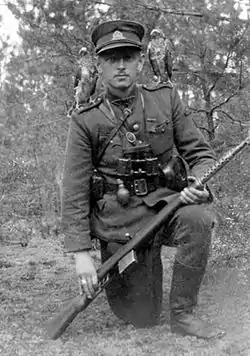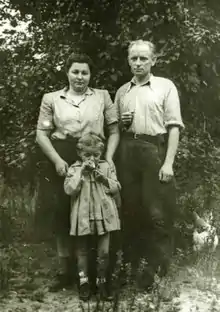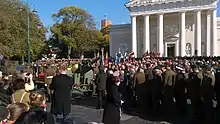Adolfas Ramanauskas
Adolfas Ramanauskas (March 6, 1918 – November 29, 1957), code name Vanagas, was a prominent Lithuanian partisan and one of the leaders of the Lithuanian resistance. Ramanauskas was working as a teacher when Lithuania was re-conquered by the Soviet Union from Nazi Germany in 1944–45. He joined the anti-Soviet resistance, advancing from a platoon commander to the chairman of the Union of Lithuanian Freedom Fighters. From 1952 he lived in hiding with fake papers.[1] Betrayed, he was arrested, tortured, and eventually executed by the KGB,[2] the last partisan commander to be captured.[1][3]
Colonel Adolfas Ramanauskas | |
|---|---|
 | |
| Vice Chairman of the Union of Lithuanian Freedom Fighters | |
(Posthumously named Head of State in November 2018) | |
| In office November 26, 1954 – November 29, 1957 | |
| Preceded by | Jonas Žemaitis (as Chairman of the Union of Lithuanian Freedom Fighters) |
| Succeeded by | Vytautas Landsbergis (first head of state of independent Lithuania in 1991) |
| Personal details | |
| Born | March 3, 1918 New Britain, Connecticut, U.S. |
| Died | November 29, 1957 (aged 39) Vilnius, Lithuanian SSR, Soviet Union |
| Resting place | Antakalnis Cemetery |
| Spouse(s) | Birutė Mažeikaitė (m. 1945) |
| Children | 1 |
| Profession | Teacher, journalist |
| Military service | |
| Allegiance | |
| Years of service | 1945–1956 (Lithuanian partisans) |
| Rank |
|
| Commands | Union of Lithuanian Freedom Fighters |
| Awards |
|
After Lithuania regained independence in 1990, Ramanauskas was posthumously awarded the Order of the Cross of Vytis and promoted to brigadier general.[2] In 2018, members of the Seimas passed a resolution identifying Ramanauskas as the "highest-ranking Lithuanian official in the fight against Soviet occupation" from 1954 to 1957.[4]
Biography
Early life
Ramanauskas was born to a Lithuanian immigrant family in New Britain, Connecticut, United States. In 1921, his family returned to Lithuania, bought 6 hectares (15 acres) of land in Bielėnai near Rudamina, and took up farming.[5] Ramanauskas graduated from Galiniai primary school in 1930, and from Lazdijai secondary school in 1937. He continued his studies at the Klaipėda Pedagogical Institute (now Vilnius Pedagogical University). Just before graduation the Klaipėda Region (Memel Territory) was ceded to Nazi Germany, and the institute was consequently evacuated to Panevėžys.[5] The same year, Ramanauskas enrolled into the Kaunas War School. He graduated with the rank of second lieutenant in the reserve forces.[6] His class of 1940 was the last graduating class before the Soviet Union occupied Lithuania in June 1940.
After graduation, Ramanauskas moved to Krivonys near Druskininkai where he became a teacher. He participated in the anti-Soviet June Uprising at the start of the 1941 German invasion of Russia.[7] During the Nazi occupation of Lithuania, Ramanauskas lived in Alytus and taught mathematics, the Lithuanian language, and physical education at the Alytus Teachers' Seminary.
The Red Army's eventual victory over the Wehrmacht led to the re-occupation of Lithuania. In early 1945, Ramanauskas joined the Lithuanian partisans who waged guerrilla warfare against the Soviet occupants. He adopted the nom-de-guerre Vanagas ("Hawk") and joined partisan formations in southern Lithuania (Suvalkija and Dzūkija), which were most active among Lithuanian partisans.[8]
Guerrilla warfare

Ramanauskas joined a partisan platoon operating in the environs of Nemunaitis and Alovė and was immediately elected its commander. He organized disorganized resistance members into a 140-men Merkinė company (later reorganized into a battalion).[7] The early stages of resistance saw open battles with the NKVD and destruction battalion forces. Two of such encounters were in the Varčios Forest between Alovė and Daugai on June 14 and 23, 1945. During the shootout, 30–47 partisans were killed and 6–14 taken prisoners.[9] On July 1, 1945, Ramanauskas was promoted to commander of Merkys Brigade (composed of three battalions – Merkinė, Marcinkonys and Druskininkai). In October 1945, in Nedzingė he married Birutė Mažeikaitė, a former student at the Alytus Teachers' Seminary and fellow partisan fighter (codename Vanda).[5] On December 15, 1945, he led a daring but unsuccessful attack on Merkinė. The partisans destroyed Soviet records, but they could not free prisoners or overpower the Soviet troops in the local church.[8] Ramanauskas strove to improve organization and centralized command of the partisans. He became commander of the Dainava Command (Lithuanian: Dainavos apygarda) after the death of Dominykas Jėčys-Ąžuolis in September 1947 and of the South Lithuania Region (Lithuanian: Pietų Lietuvos sritis) in 1948. He also wrote, edited, and published numerous partisan newspapers, including Mylėk Tėvynę (Love Your Fatherland, 1946–47), Laisvės varpas (The Bell of Freedom, 1947–49), Свободное слово (The Free Word, 1947–49), a Russian-language newspaper for Soviet soldiers, and Miško brolis (The Forest Brother, 1951–52).[5]
In February 1949, he participated in a meeting of all partisan commanders in the village of Minaičiai. The Union of Lithuanian Freedom Fighters, chief command of the partisans, was established during the meeting. Ramanauskas was elected to the presidium of the Union and as the first deputy of its chairman Jonas Žemaitis.[5] He was also promoted to the rank of Major. Ramanauskas was one of the signatories of the Lithuanian Partisans Declaration of February 16, 1949, which proclaimed Lithuania as a democratic republic and the Lithuanian nation as a sovereign power.[10]
In fall 1949, Ramanauskas was further promoted to Colonel and chief commander of the defensive forces of the Union of Lithuanian Freedom Fighters. When Žemaitis resigned due to poor health in 1952, Ramanauskas became the leader of the Union.[5] However, by that time the armed resistance had diminished. Due to heavy losses organized structures broke down and partisans continued their struggles individually. Ramanauskas officially ordered cessation of armed struggle in favour of passive resistance.[6]
.jpg.webp)
He obtained fake documents and lived in hiding. While in hiding he wrote three-part memoirs, which were hidden by trusted people and uncovered only in 1988–89 during the era of glasnost and first published as Daugel krito sūnų… (Many Sons Have Fallen…) in 1991. The KGB formed a permanent operational group led by Petras Raslanas and Nachman Dushanski to capture Ramanauskas, which, according to Auksutė Ramanauskaitė-Skokauskienė, had as many as thirty agents in 1956.[2][5][11] Ramanauskas was betrayed by Antanas Urbonas, a former classmate at Kaunas, and arrested on October 11, 1956. He was taken to the KGB prison in Vilnius (now the Museum of Genocide Victims) and tortured. On October 12, barely alive, he was transferred to a hospital, where doctors noted his many wounds – punctured eye, missing testicles, bruised stomach, etc.[5][12] Sentenced to death on September 25, 1957, Ramanauskas was executed on November 29, 1957. His wife Birutė Mažeikaitė was sentenced to 8 years in the Gulag system.[2]
Controversy
Ramanauskas has been accused of supporting the Lithuanian Activist Front and commanding a paramilitary group that persecuted the Jewish community of Druskininkai in 1941.[13][14][15][16][17][18] In response to these charges (along with similar allegations against Povilas Plechavičius, Kazys Škirpa, Antanas Baltūsis-Žvejys, and Jonas Noreika), members of the Union of Nationalist Youth of Lithuania marched in Kaunas in February and March 2016 under the banners "We Know Our Nation's Heroes" and "Lithuania for Lithuanians".[19][20] The Lithuanian Ministry of Foreign Affairs and state-funded Genocide and Resistance Research Centre maintain that the allegations are "lies [...] spread first by the Soviet-era KGB secret police to discredit him."[21][22] Historian and politician Arvydas Anušauskas has similarly claimed that the allegations have their origins in a "Russian backed anti-Lithuanian disinformation campaign" led by KGB officer Nachman Dushanski.[23]
Awards
On 9 April 1946, Ramanauskas-Vanagas was awarded the Zeal Stripe (Uolumo juostelė) for conducting organizational work for the resistance movement and the Bravery Stripe (juostelė "Už narsumą") for heading the attack on Soviet occupants in Merkinė. In 1949–1950, he received the Freedom Fight Cross with Swords (1st and 2nd class).[24]
On 27 December 1997, Ramanauskas-Vanagas, was granted the status of a "military volunteer," and on 26 January 1998, he was posthumously granted the rank of reserve brigadier general by decree of the President of Lithuania. On 6 March 1998 Ramanauskas was awarded the Order of the Cross of Vytis (second class), and on 1 February 1999 the Order of the Cross of Vytis (first class).[24]
Grave and legacy

A book of memoirs by Ramanaukas, written between 1952 and 1956 and assembled by his daughter Auksutė, was published in 1991 under the title Daugel krito sūnų ("Many sons fell").[25] In 2018, the Genocide and Resistance Research Centre published an English translation of the work, entitled Many Sons Have Fallen in the Partisan Ranks.[26]
Ramanauskas's daughter, Auksutė Ramanauskaitė-Skokauskienė, was elected to the Seimas in 2008.
In December 2017, Israeli ambassador Amir Maimon visited Ramanauskas's daughter Auksutė, which, according to Lithuanian journalist Vaidas Saldžiūnas, "expressed indirect diplomatic support to the memory of the freedom fighter."[27] In 2017, plans to erect a monument for the 100th anniversary of Ramanaukas's birth in his native New Britain, Connecticut were cancelled following the adoption of a council petition.[28][29][30]
The following year, Ramanauskas's grave was found at the Našlaičiai (lit. Orphans) Cemetery in Antakalnis, Vilnius. The identity was confirmed by anthropological analysis of the skull, DNA investigation, and photographic matching. His death was the result of a gunshot in the vertex of his head.[31] His remains were discovered and reburied in a state funeral among other state leaders in the Antakalnis Cemetery,[32] at which Lithuanian President Dalia Grybauskaitė spoke, diplomats from 30 countries and thousands of ordinary people participated.[33][34] The Seimas designated 2018 the year of Ramanauskas-Vanagas.[35]
On May 4, 2019, a monument to Adolfas Ramanauskas was unveiled in Chicago, a decision which was criticised by some organisations, including the Simon Wiesenthal Center, the World Jewish Congress, and the Jewish Agency."[13][18][36][37][38][39][40] The Lithuanian Jewish Community Council, however, issued a statement that "at the present time [they have] no reliable information implicating Lithuanian partisan leader Adolfas Ramanauskas in Holocaust crimes."[41]
Further reading
- Ramanauskas, Adolfas (2007). Daugel krito sūnu̜... : partizanu̜ gretose (in Lithuanian). Vilnius: Lietuvos gyventoju̜ genocido ir rezistencijos tyrimo centras. ISBN 978-9986-757-79-5. OCLC 946092374. Archived from the original on 3 April 2011.CS1 maint: ref=harv (link)
- Ramanauskas, Adolfas (2018). Many Sons Have Fallen in the Partisan Ranks. Vilnius: Genocide and Resistance Research Centre of Lithuania. ISBN 978-609-8037-76-0. OCLC 1102612536.CS1 maint: ref=harv (link)
- Anušauskas, Arvydas (2018). Aš esu Vanagas (in Lithuanian). Vilnius: Dominicus Lituanus. ISBN 978-609-8227-07-9. OCLC 1099934397.CS1 maint: ref=harv (link)
- Ramanauskaitė-Skokauskienė, Auksutė (2007). Adolfas Ramanauskas-Vanagas: Partisan Commander General. Kaunas: Naujasis lankas. ISBN 978-9955-03-424-7.CS1 maint: ref=harv (link)
- Obituary of Adolfas Ramanauskas-Vanagas. The State Funeral Ceremony on 5 and 6 October 2018 in Vilnius
References
- Statiev, Alexander (2010). The Soviet Counterinsurgency in the Western Borderlands. Cambridge University Press. p. 134. ISBN 978-0-521-76833-7.
- "Adolfas Ramanauskas-Vanagas" (in Lithuanian). Lietuvos gyventojų genocido ir rezistencijos tyrimo centras. 2004-01-30. Retrieved 2011-03-27.
- Vardys, Stanley (September 1963). "The Partisan Movement in Postwar Lithuania". Slavic Review. 22 (3): 499–522. doi:10.2307/2492495. JSTOR 2492495.
- "A. Ramanauskas-Vanagas pripažintas buvęs valstybės vadovu". lrt.lt. Retrieved 12 October 2019.
- Ramanauskaitė-Skokauskienė, Auksutė (2007). Adolfas Ramanauskas-Vanagas Partisan Commander General. Kaunas: Naujasis lankas. pp. 12–16. ISBN 978-9955-03-424-7.
- Simas Sužiedėlis, ed. (1970–1978). "Ramanauskas, Adolfas". Encyclopedia Lituanica. IV. Boston, Massachusetts: Juozas Kapočius. p. 432. LCC 74-114275.
- Lukšas, Aras (2010-12-03). "Paskutinis partizanų vadas". Lietuvos žinios (in Lithuanian). 277 (12806). ISSN 1822-1637. Archived from the original on 2010-12-07.
- Čekutis, Ričardas; Dalius Žygelis (2007-10-15). "Laisvės kryžkelės. Dainavos apygarda" (in Lithuanian). bernardinai.lt. Retrieved 2011-03-27.
- "Varčios mūšio 60-osios metinės" (in Lithuanian). Lietuvos gyventojų genocido ir rezistencijos tyrimo centras. 2005-06-17. Retrieved 2011-03-27.
- "Niagara Falls to light up in Lithuanian colors on February 16". The Baltic Times. 7 February 2019. Retrieved 16 June 2019.
- "Vanago legenda palaikė nesusitaikymo dvasią". genocid.lt (in Lithuanian). Retrieved 6 October 2019.
- Antanavičius, Ugnius (31 October 2017). "A.Ramanausko-Vanago byla: ką joje perskaitė, bet nutylėjo R.Vanagaitė?". 15min.lt.
- "Simon Wiesenthal Center Urges Lithuanian Community: "Don't Build Monument To Honor Nazi Collaborator"". Simon Wiesenthal Center. 2 May 2019. Retrieved 7 May 2019.
- Zuroff, Efraim (23 August 2018). "Netanyahu Should Not Tolerate Holocaust Distortion in Lithuania". Retrieved 6 July 2019.
- Balčiūnas, Evaldas (27 March 2014). Translated by Vasil, Geoff. "Footprints of Adolfas Ramanauskas-Vanagas in the Mass Murder of the Jews of Druskininkai". Defending History. Retrieved 7 May 2019.
- Liphshiz, Cnaan (30 October 2017). "Lithuanian publisher recalls books by writer who triggered Holocaust debate". The Times of Israel.
- Schmitt, Michael N.; Arimatsu, Louise; McCormack, T. (2010). Yearbook of International Humanitarian Law. 13. T.M.C. Asser Press. p. 582. ISBN 978-90-6704-811-8.
- Cohen, Ben (8 May 2019). "Row Simmers Over Chicago Monument to Lithuanian National Hero Implicated in WW2 Crimes Against Jews". The Algemeiner. Retrieved 19 May 2019.
- "March Commemorates Nazi Collaborators in Lithuania". Haaretz. 17 February 2016. Retrieved 15 July 2019.
- Kiurė, Vilma Fiokla (11 March 2016). "Neo-Nazis Given Central Vilnius Again on March 11th Independence Day". Defending History. Retrieved 15 July 2019.
- Kirby, Paul (8 May 2019). "Lithuania monument for 'Nazi collaborator' prompts diplomatic row". BBC News. Retrieved 6 July 2019.
- "Lithuania's Foreign Minister meets with Director of International Jewish Affairs at American Jewish Committee". Ministry of Foreign Affairs of the Republic of Lithuania. 8 May 2019. Retrieved 6 July 2019.
- Iržikevičius, Ruslanas. "A response to E. Zurof regarding A. Ramanauskas-Vanagas". lithuaniatribune.com. Retrieved 12 October 2019.
Already after the end of the Second World War, KGB lieutenant colonel N. Dushanski, who received all his awards for supposed combat “merits” (the destruction of the Lithuanian anti-communist resistance movement), willingly participated in a Russian backed anti-Lithuanian disinformation campaign. It appears that namely N. Dushanski’s false claims regarding A. Ramanauskas are the basis for Efraim Zuroff’s tweet on October 28, 2017, stating, “The role of a Lithuanian hero in the crimes of the Holocaust should not allow him to be called a state hero in 2018.”
- "Adolfas Ramanauskas-Vanagas: The State Funeral Ceremony on 5 and 6 October 2018" (PDF). genocid.lt. p. 4. Retrieved 12 October 2019.
On 9 April 1946, A. Ramanauskas-Vanagas was awarded the Zeal Stripe (Uolumo Juostelė) for doing organizational work to help the resistance movement; he was also given the Bravery Stripe for heading the attack on Merkinė.
- Šileika, Antanas (Fall 2009). "New Notes from the Underground: The Partisan War". Lituanus: Lithuanian Quarterly Journal of Arts and Sciences. 55 (3). ISSN 0024-5089. Retrieved 16 July 2019.
- "Many Sons have Fallen / In the partisan ranks". Lietuvos gyventojų genocido ir rezistencijos tyrimo centras (in Lithuanian). Retrieved 16 July 2019.
- Saldžiūnas, Vaidas (15 December 2017). "Israel sends a message to Vanagaitė regarding Ramanauskas-Vanagas". Delfi. Lithuania Tribune. Retrieved 4 October 2019.
- "JAV pagerbs Adolfą Ramanauską – Vanagą". Genocid.lt. Retrieved 18 December 2017.
- "Ramanauskas Monument Halted". New Britain Independent. 7 April 2018. Retrieved 10 October 2019.
- "Council Petition Would to Halt Ramanauskas Monument, Pending Investigation". New Britain Independent. 2 April 2018. Retrieved 10 October 2019.
- Beniušis, Vaidotas. "Vilniuje rasti partizanų vado A.Ramanausko-Vanago palaikai". 15min.lt. Retrieved 7 June 2018.
- "Adolfas Ramanauskas-Vanagas: President of the Struggling Lithuania". Historical Presidential Palace of the Republic of Lithuania in Kaunas. Retrieved 12 October 2019.
- "Diplomats from 30 countries paid final respects to Lithuania's partisan commander". en.delfi.lt. Retrieved 4 October 2019.
- "State funeral of Adolfas Ramanauskas-Vanagas in Vilnius on October 5-6th". LTLife. Retrieved 15 July 2019.
- "Lithuania marks 28 yrs of restored independence, 100th anniversary of partisan leader". Delfi. 11 March 2018. Retrieved 16 July 2019.
- "WJC opposes Chicago monument honoring Lithuanian commander alleged to have collaborated with Nazis to murder Jews". World Jewish Congress. 4 June 2019. Retrieved 26 June 2019.
- Alexander, Inigo (8 May 2019). "Lithuania criticised over monument to war 'hero' who led vigilante gang persecuting Jews". The Telegraph.
- "Herzog: 'Moral obligation' to remove Chicago monument of Nazi collaborator". The Jerusalem Post. 2 June 2019.
- Baynes, Chris (8 May 2019). "Monument for Lithuanian 'Nazi collaborator' in Chicago sparks international row". The Independent.
- "Čikagoje atidengtas paminklas partizanų vadui Adolfui Ramanauskui-Vanagui". 15min.lt. Retrieved 4 May 2019.
- "LJC Statement on Adolfas Ramanauskas". 8 May 2019. Retrieved 6 July 2019.